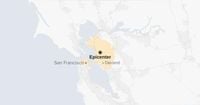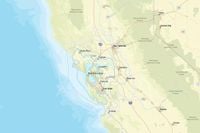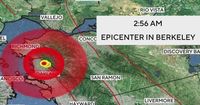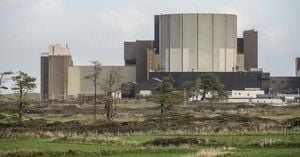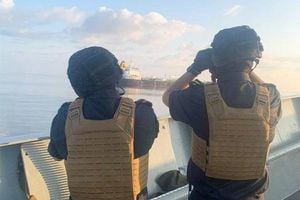In the early hours of Monday, September 22, 2025, a magnitude 4.3 earthquake jolted the San Francisco Bay Area out of its slumber, sending a sharp shake through homes, businesses, and nerves across Northern California. The quake, which struck at 2:56 a.m. Pacific time just east-southeast of Berkeley, was felt by tens of thousands, from as far south as Salinas to as far north as Chico, according to the United States Geological Survey (USGS).
Initial USGS reports placed the magnitude at 4.6, but after further analysis, it was revised to 4.3. The epicenter was pinpointed near the corner of Dwight Way and Piedmont Avenue, just a stone’s throw from the UC Berkeley campus, and at a depth of about 4.7 miles. This location sits squarely on the notorious Hayward fault, a major seismic threat that runs for 74 miles through the East Bay and into San Jose. The Hayward fault has a storied past: its most significant recorded quake, a magnitude 6.8 event in 1868, released more than 5,600 times the energy of Monday’s tremor, according to Scientific American.
Despite its relatively modest size compared to California’s seismic history, the 4.3 magnitude quake was the most powerful to hit the Bay Area in three years—since a magnitude 5.1 event near Mt. Hamilton in October 2022, as reported by the Los Angeles Times. The USGS said that more than 24,000 people (and by some counts nearly 26,000) reported feeling the shaking through its “Did You Feel It?” online tool, a testament to the quake’s widespread reach and the population density of the region.
Residents from Berkeley, Oakland, San Francisco, Albany, Alameda, San Leandro, Piedmont, Orinda, Lafayette, Walnut Creek, Richmond, and beyond described being rudely awakened. "Things were shaking in our newsroom," posted Dave Clark, a news anchor for KTVU-TV, capturing the surprise that rippled through the area. Laura Sonido of Alameda recounted, "It was strong enough to where I could hear my windows rattling. Nothing broke in the house, but the mirrored bathroom cabinets swung open. Thankfully, nothing spilled out." In the Oakland Hills, a listener told KCBS radio that dishes spilled across the floor, while in Berkeley, a butcher shop’s display window shattered, according to KTVU-TV.
For many, the quake brought a swift reminder of the region’s seismic reality. "We definitely live in earthquake country, here in California. This is a very typical earthquake for what we would expect in the Bay Area, on one of our major faults," UC Berkeley seismologist Angie Lux explained to CBS News Bay Area. The Hayward fault, she noted, is closely monitored by scientists due to its potential for much larger, more destructive events.
Monday’s shaking was classified as “light” on the Modified Mercalli Intensity Scale, but that didn’t stop the nerves. Estrella, a freshman at UC Berkeley from the Central Coast, told CBS News Bay Area, "I thought my bunk bed was going to collapse, as the epicenter was close." Nick Norman, another resident, recalled, "My bed is shaking so my first thought was wait, see how long it lasts. And then I thought, well what if it keeps going? So I thought, where do I need to go for safety in case."
The quake triggered the MyShake early warning app, powered by the USGS ShakeAlert system, which blared on phones across the region. Some residents received the alert at almost the same moment as the shaking began. The USGS and local officials took the opportunity to remind Bay Area residents of the importance of preparedness. Mayor Daniel Lurie advised, "Stay prepared, San Francisco. Remember to drop, cover, and hold on when shaking starts." The USGS echoed this, offering tips such as securing movable items, creating a disaster plan, and organizing disaster supplies in convenient locations.
Public infrastructure responded quickly. Bay Area Rapid Transit (BART) slowed trains systemwide to conduct safety inspections, warning riders of delays up to 20 minutes as a precaution. In a statement to CBS News Bay Area, BART said it did not expect major delays due to the quake, but safety checks were essential. San Francisco’s Department of Emergency Management reported an uptick in 911 calls from those who felt the shaking, but as of Monday morning, there were no reports of injuries or major damage in the city. "First responders are assessing any impact to our city, and we will give an update later today," Mayor Lurie posted online.
Aftershocks are a natural part of the seismic sequence, and Monday was no exception. A magnitude 2.6 aftershock struck at 8:01 a.m. near Claremont and Ashby avenues, close to the Claremont Resort and Club, preceded by a magnitude 2.1 tremor about 17 minutes earlier. The USGS estimated a 4% chance of another magnitude 4 or greater earthquake in the following week, though that probability dropped by midday.
While the quake did not pose any tsunami threat, as confirmed by the National Tsunami Warning Center, it did serve as a wake-up call—literally and figuratively—for millions living atop one of the world’s most closely watched fault systems. The Hayward fault’s potential for devastation remains a serious concern. According to a USGS scenario, a hypothetical magnitude 7 earthquake along the fault could kill 800 people, injure 18,000, and leave thousands trapped in collapsed buildings and elevators.
Seismologists are still reviewing data and may update the quake’s magnitude and the shake-severity maps as more information comes in. The event has been tentatively linked with 10 other smaller quakes in the region over the past month, most too weak for people to notice, according to Scientific American.
For now, the September 22 quake stands as a vivid reminder of the Bay Area’s seismic vulnerability and the importance of readiness. As the dust settles and the data is analyzed, residents are left with the same age-old question: when will the next big one strike?
